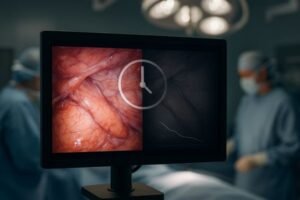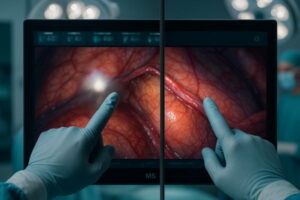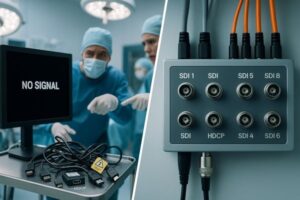You have new imaging equipment, but it will not connect to your existing surgical monitor. This creates delays, workflow disruptions, and requires a frustrating search for unreliable adapters.
Signal [interface compatibility](https://reshinmonitors.com/or-interface-compatibility-switching/ “interface compatibility”) is critical for successful surgical monitor integration. It directly impacts workflow efficiency, image quality, and overall system reliability by ensuring seamless connectivity between diverse medical devices without signal loss, latency, or the need for cumbersome converters.

The modern operating room is a complex ecosystem of technology from many different manufacturers. An endoscopic camera, a C-arm, and an ultrasound machine may all need to connect to the same display during a single procedure. If the monitor cannot accept the signals from these devices, it becomes a bottleneck rather than a tool for clarity. The type and number of input ports on a monitor1 dictate its ability to integrate into this environment. This is not just a matter of convenience; it is a fundamental aspect of surgical safety and efficiency2. This article will explain why versatile interface support3 is essential, how it impacts workflow, and what can go wrong when compatibility is overlooked. We will also clarify the common standards and explain our approach to ensuring our monitors are ready for any integration challenge.
Why is multi-interface support crucial in modern surgical monitors?
You just invested in a new imaging tower. Now you find its video output is incompatible with your monitors, forcing you to use adapters that add clutter and another point of failure.
Multi-interface support is crucial because it allows a single monitor to connect directly to a wide variety of medical imaging equipment from different manufacturers. This ensures universal compatibility with systems like endoscopes, fluoroscopes, and surgical cameras, maximizing the monitor’s utility.

Hospitals and surgical centers rarely source all their equipment from a single vendor. A typical operating room might feature an endoscopic system from one brand, a C-arm from another, and a surgical microscope4 from a third. Each of these devices may output its video signal using a different interface standard. For example, many endoscopic cameras use HDMI or DVI, while mobile C-arms often rely on SDI for its long-distance signal integrity. Without a monitor that supports all these native connections, staff must resort to external signal converters5. These converters add clutter, require their own power source, and introduce potential points of failure into the imaging chain. A monitor with comprehensive, built-in interface support6 eliminates these issues. Our MS192SA 19-inch monitor, for instance, is designed for broad utility in examination rooms and smaller ORs. It includes multiple inputs to ensure it can connect directly to various legacy and modern sources. This built-in versatility makes the monitor a reliable and future-proof investment, capable of adapting as other equipment in the surgical suite is upgraded or replaced over time.
How does interface compatibility impact workflow in hybrid ORs?
In a complex hybrid procedure, your team wastes precious minutes trying to switch the display from the C-arm to the endoscope. This interruption breaks surgical flow and adds unnecessary stress.
In hybrid ORs, seamless interface compatibility allows for instant, reliable switching between different imaging modalities. This prevents procedural delays, reduces the need for technical adjustments during surgery, and maintains a smooth, uninterrupted workflow, which is critical for patient safety.

A hybrid operating room7 combines advanced imaging systems, such as a fixed C-arm, with a traditional surgical suite. This allows for complex, minimally invasive procedures where the surgical team may need to switch between real-time fluoroscopy, endoscopy, and ultrasound views in rapid succession. In this high-stakes environment, workflow efficiency8 is paramount. If a monitor cannot instantly recognize and display a signal when it is plugged in, the procedure halts. The surgical team must wait while a technician troubleshoots the connection, breaking concentration and prolonging the time the patient is under anesthesia. True interface compatibility9 means the monitor’s firmware can immediately handshake with any connected device, automatically adjusting to the correct resolution and timing. This allows for plug-and-play simplicity. Our MS220S FHD endoscopic monitor is engineered with this workflow in mind. Its robust input processing ensures that when a surgeon calls for a new image source, it appears on the screen instantly and correctly, without flicker or delay. This reliability keeps the focus on the patient, not on the technology.
Workflow Impact of Interface Compatibility
| Scenario | With Seamless Compatibility | With Poor Compatibility (Using Converters) |
|---|---|---|
| Switching Sources | Instantaneous, single button press | Manual cable swapping, converter adjustment |
| Procedural Time | Minimized, no technical delays | Increased due to troubleshooting |
| Staff Focus | On the surgical procedure | On managing and fixing equipment |
| System Reliability | High, fewer points of failure | Low, converters and extra cables add risk |
| OR Clutter | Minimal, direct connections | High, extra boxes and power cables |
Can mismatched interfaces lead to image quality loss or delays?
You are using a converter to connect a 4K camera to your monitor. The image appears soft and slightly delayed, making precise movements difficult and eroding your confidence in the display.
Yes, mismatched interfaces or the use of signal converters can cause significant image quality degradation and latency. These issues include resolution downscaling, color space errors, digital noise, and perceptible signal delays that can compromise surgical precision and diagnostic accuracy.

A video signal is more than just an image; it is a complex data stream with specific timing, resolution, and color information. When you use a converter to change a signal from one standard to another (e.g., DisplayPort to HDMI), you are fundamentally altering this data stream. This process is rarely perfect. Low-quality converters can fail to properly negotiate the highest possible resolution, forcing a high-resolution 4K source to be displayed at 1080p. They can also misinterpret color space information10, leading to washed-out or oversaturated colors. Furthermore, the act of processing and converting the signal takes time, introducing latency or “lag”11 between the camera and the screen. In surgery, even a delay of a few milliseconds can disrupt a surgeon’s hand-eye coordination. Our MS275P 4K surgical monitor12 avoids these problems by providing native inputs for high-resolution sources. By connecting a 4K camera directly via its HDMI 2.0 or DisplayPort 1.2 inputs, the signal path remains digital and uncompromised from source to screen. This guarantees the surgeon sees the sharpest, most color-accurate, and lowest-latency image possible.
Common Issues from Interface Mismatches
| Mismatch Type | Potential Problem | Impact on Surgery |
|---|---|---|
| Using HDMI-to-SDI Converter | Increased latency, compression artifacts | Delayed visual feedback, loss of fine detail |
| Connecting 4K Source to HD Monitor | Resolution downscaling | Critical details are lost; image appears soft |
| Analog (VGA) to Digital (HDMI) | Signal noise, inaccurate colors | Poor image clarity, potential for misinterpretation |
| HDCP Handshake Failure | Blank screen (“No Signal”) | Complete loss of image during a procedure |
Is there a standard interface preferred for surgical video systems?
You are planning a new OR and need to choose your video infrastructure. The choice between SDI, HDMI, and DisplayPort is confusing, and you want to avoid selecting an outdated standard.
While there is no single universal standard, SDI (Serial Digital Interface) is often preferred for its robust, locking connectors and ability to transmit uncompressed video over long distances (up to 100 meters), making it ideal for routing signals within an OR. HDMI and DisplayPort are also very common for high-resolution sources.

The choice of interface often depends on the specific application and equipment involved. Each major standard has distinct advantages. SDI13 is a broadcast-industry staple that has been widely adopted in medicine for its reliability. Its BNC connectors lock securely in place, preventing accidental disconnection, and it can carry pristine video signals over long coaxial cables without degradation, which is perfect for connecting equipment across a large operating room. HDMI14 is the most ubiquitous digital interface, found on countless devices. It is excellent for transmitting high-resolution 4K video and audio over shorter distances. DisplayPort15 offers the highest bandwidth, making it the best choice for the most demanding 4K or higher-resolution signals at high frame rates, often used to connect to computer-based imaging systems. A truly versatile surgical monitor should not force you to choose one. Instead, it should offer all of them. Our MS321PC 4K monitor, for example, is equipped with 12G-SDI, HDMI 2.0, and DisplayPort 1.2 inputs. This allows it to serve as a central hub, capable of connecting to virtually any modern or legacy surgical imaging device without compromise.
How does Reshin ensure broad interface compatibility in its surgical monitor designs?
You are tired of equipment connectivity issues. You need a surgical monitor that works reliably with all your imaging sources, right out of the box, without any technical headaches or excuses.
We ensure broad compatibility by designing our monitors with a comprehensive suite of inputs, including SDI, HDMI, DVI, and DisplayPort. We then rigorously test the monitor’s firmware against a wide range of common surgical imaging devices to guarantee plug-and-play performance.

Our design philosophy is centered on solving real-world clinical challenges. We know that interface incompatibility16 is a major source of frustration and risk in the OR. Therefore, we approach compatibility as a core engineering requirement, not an afterthought. First, we equip our monitors with a versatile array of physical ports to meet the needs of a mixed-vendor environment. Second, and more importantly, we invest heavily in developing robust firmware17. Our engineering team maintains a lab filled with common endoscopic camera systems, C-arms, and other imaging sources from major medical device manufacturers. We physically connect our monitors, like the MS321PB, to this equipment and perform rigorous testing18. We test for signal detection speed, resolution negotiation, color accuracy, and stability over long periods. This process allows us to fine-tune our firmware to handle not just perfect, standard signals, but also the slight variations that can occur with different devices and long cable runs. The result is a monitor that you can trust to work seamlessly with the equipment you already have and the new technology you plan to acquire in the future.
Conclusion
Ultimately, interface compatibility is the foundation of a reliable and efficient surgical visualization system. Choosing a monitor with broad, native support for key standards ensures seamless integration, optimal image quality, and a safer workflow. To explore surgical monitors with extensive interface compatibility, contact Reshin at martin@reshinmonitors.com.
- Learning about the necessary input ports on monitors can help in selecting the right equipment for optimal integration in surgical environments. ↩
- Exploring the relationship between surgical safety and efficiency with technology can provide insights into improving patient outcomes and operational workflows. ↩
- Understanding versatile interface support is crucial for ensuring seamless integration of surgical devices, enhancing safety and efficiency in procedures. ↩
- Discover essential features of surgical microscopes that enhance surgical precision and outcomes. ↩
- Learn about the potential issues signal converters can introduce in medical imaging and how to avoid them. ↩
- Explore how built-in interface support can streamline operations and enhance efficiency in medical settings. ↩
- Explore the advantages of hybrid operating rooms, which enhance surgical precision and patient safety through advanced imaging technology. ↩
- Learn about strategies to enhance workflow efficiency in surgical settings, crucial for minimizing delays and improving patient outcomes. ↩
- Discover the significance of interface compatibility in medical devices, ensuring seamless integration and optimal performance during procedures. ↩
- Learn about color space information to ensure accurate color representation in video signals, enhancing visual clarity. ↩
- Understanding latency in video signals is crucial for maintaining precision in surgeries, making this resource invaluable. ↩
- Explore how a 4K surgical monitor enhances image quality and precision in surgical procedures, ensuring better outcomes. ↩
- Explore the benefits of SDI in medical settings, especially its reliability and secure connections, crucial for surgical environments. ↩
- Learn how HDMI’s versatility and high-resolution capabilities make it a popular choice for medical devices and imaging. ↩
- Discover why DisplayPort’s high bandwidth is essential for demanding medical imaging applications, ensuring top performance. ↩
- Understanding interface incompatibility can help you appreciate the importance of compatibility in medical technology. ↩
- Learning about firmware’s role can enhance your understanding of device compatibility and performance in clinical settings. ↩
- Exploring rigorous testing practices can provide insights into ensuring safety and reliability in medical devices. ↩



